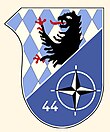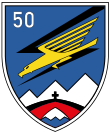Light Combat Squadron
As Leichtes Kampfgeschwader (LeKG) were temporarily referred to in the air force of the Bundeswehr as flying units that were used with the Fiat G.91 to support the army as fighter-bombers and reconnaissance aircraft.
assignment
The main task of the light combat squadron was the use as a fighter-bomber for close air support . In the secondary role, battlefield reconnaissance was planned, but due to the technical equipment it was primarily based on eye reconnaissance with confirmation by cameras. Appropriate equipment ensured that the G.91 (called “Gina” in the pilot's jargon) could be used in both operational roles (fighter-bomber / reconnaissance aircraft).
Restrictions in the fulfillment of the order resulted from the limited all-weather capability and the daylight dependence of the G.91. In addition, due to the short range, it was necessary to plan the use of advanced airfields (Deployed Operating Bases - DOB), for example prepared field airfields or motorway landing sites in the front combat zone.
The original plan to arm the G.91 with nuclear weapons as a fighter-bomber was abandoned due to technical problems, among other things.
structure
Until 1967, the G.91 squadrons were divided into two flying squadrons , each with three swarms , technical staff and weather advice. In addition, the associations had an air base squadron with a non-commissioned officer training and security squadron, an air force medical team and a geophysical advice center.
As of May 1967, all G.91 combat units were uniformly renamed as Light Combat Squadrons. The swarm structure was abandoned and the squadron was divided into a flying group and a supply group. The flying group now had a fighter-bomber and a reconnaissance squadron.
From 1971, the three-group structure (flying, technical and air base group) was introduced analogous to the starfighter squadrons.
Associations
Initial plans envisaged the formation of six light combat squadrons of 42 aircraft each. Ultimately, only four active squadrons and the Luftwaffe 50 weapons school were equipped to train the pilots. In addition, "Ginas" also flew with the Air Force Tactical Training Command in Portugal .
Light Combat Squadron 41
In July 1963, Fighter Bomber Wing 35 was converted from F-84F to G.91. On January 1, 1966, the association was named Leichtes Kampfgeschwader 41.
The squadron was stationed as part of the 3rd Air Force Division in Husum . In the event of a defense , a submission to the Allied Forces Northern Europe (AFNORTH) command and a transfer to Hohn was planned. The association was renamed Jagdbombergeschwader 41 in October 1980, still equipped with the G.91 .
Light Combat Squadron 42
The origin of the light combat wing 42 lies in the fighter wing 73 . This association was equipped with the Saber Mk.6 and was commissioned in October 1964 to take over the role of fighter-bomber. With the expansion of the role - daytime hunting continued to be carried out in addition to the fighter-bomber role - the squadron was renamed Jagdbombergeschwader 42. The G.91 ran from April 1966; in May 1967 the reclassification took place, and from this point on the association was called Leichtes Kampfgeschwader 42.
Stationed in peacock field in the Hunsrück and part of the 1st Air Force Division, the unit would have been subordinate to the 4th Allied Tactical Air Force (4th ATAF) during the war and moved to the advanced airfields Kitzingen and Giebelstadt . The LeKG 42 was merged with Fighter Bomber Wing 35 in April 1975.
Light Combat Squadron 43
The Fighter Bomber Wing 43 was from the rest of the staff originally drawn up Reconnaissance Wing 54 and from in October 1964. leak after Oldenburg erected laid Fighter Squadron 72nd From May 1966 the Saber Mk.6 was converted to the G.91, and one year later it was renamed to Leichtes Kampfgeschwader 43.
The squadron was under the command of the 3rd Air Force Division and stationed in Oldenburg, where parts of the Air Force 10 weapons school were located until 1962. During the war, the Wunstorf and Bückeburg airfields and leadership by the 2nd Allied Tactical Air Force (2nd ATAF) were planned as DOB . On October 1, 1979, the association was renamed again to Jagdbombergeschwader 43, which was equipped with the Alpha Jet from 1981 .
Light Combat Squadron 44
The Light Combat Wing 44 was created on July 1, 1965 from the reconnaissance wing 53 in Leipheim . Like LeKG 42, the association was subordinate to the 1st Air Force Division in peacetime and would also have been led by the 4th ATAF in the event of a defense. The squadrons have moved to Roth and Oberpfaffenhofen airfields . The LeKG 44 was dissolved on June 30, 1975.
Luftwaffe 50 / Light Combat Wing 49 ( equipment unit )
The Light Combat Squadron 49, which was not active in peacetime, would have emerged in the event of a defense from the Luftwaffe 50 weapons school, which was relocated from Erding to Fürstenfeldbruck in 1964 and equipped with G.91 . In April 1971, the weapons school was explicitly given the structure for the Light Combat Squadron 49. For use, the squadron would have been subordinated to the 4th ATAF. In its role as a combat unit, it was subjected to a tactical review by NATO, a so-called TACEVAL (Tactical Evaluation), in October 1976. In October 1978 the Luftwaffe 50 weapons school was closed. The Fighter Bomber Wing 49 emerged from it.
literature
- Bernd Lemke; Dieter Krüger; Heinz Rebhan; Wolfgang Schmidt: The Air Force 1950 to 1970. Concept, structure, integration. Oldenbourg Wissenschaftsverlag, Munich 2006, ISBN 3-486-57973-8
Web links
- Holdings BL 17 “Combat Groups of the Air Force” in the Federal Archives
- Traditional community JaboG 43 e. V .: "History of the FlgH Oldenburg" (PDF; 92 kB)
Individual evidence
- ^ History of the Oldenburg Air Base . In: Traditionsgemeinschaft Jagdbombergeschwader 43. Accessed June 15, 2018 .
- ↑ a b Hartmut Jung: "Fürstenfeldbruck - Chronicle of an Air Base" 2nd edition, 1994, Landsberg a. Lech, ISBN 3-926253-99-1






